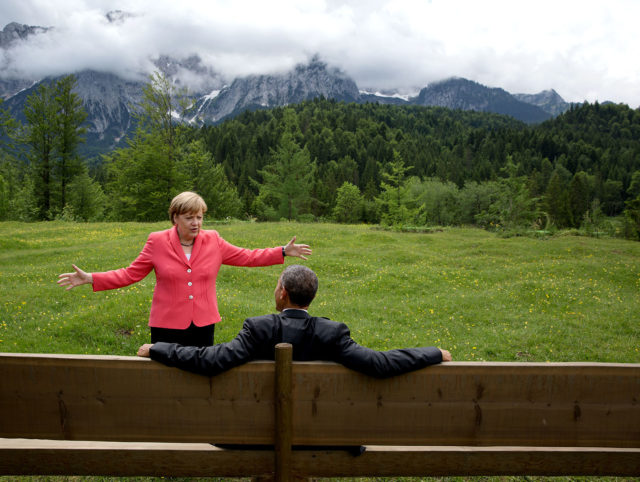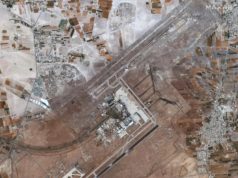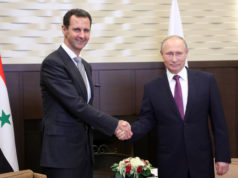
America’s retrenchment in foreign policy has been driven not only by ideological considerations but also by public disillusionment with the results of long wars in Afghanistan and Iraq, and by complex policy dilemmas, the perceived intractability of regional problems, and economic and budgetary constraints. And “realists” from both the academic and policy worlds have applauded it.
In practice, of course, the retreat process has been uneven and more subtle in some areas and functions than in others. Nonetheless, President Obama’s foreign policy has more often than not been one of disengagement, conciliation of adversaries, and aversion to the use of American power that itself has been affected by marked reductions in the size of the U.S. military. This approach has been adopted with the aim of reducing conflict, motivating local actors to counterbalance regional threats, encouraging the international community to “step up” in assuming the burdens of regional stability, protecting America’s own national interests, and promoting global order.
But the results of this policy indicate that it has failed to achieve its own objectives. As a consequence, we now face an ever more dangerous world with the rise of hostile powers, fanatical terrorist movements, and worsening regional conflicts in Eastern Europe, the Middle East, and Asia. Meanwhile, our allies have become uneasy and have sought to hedge their own security commitments, while senior U.S. military and intelligence leaders warn of increasing threats to America itself.
The Obama Doctrine
Some have questioned whether an Obama Doctrine really exists. President Obama himself described his concept as, “Don’t do stupid [s . . . t].” However, there is ample evidence from his rhetoric and actions of an identifiable approach to foreign policy—whether or not the word “doctrine” is used to describe it. As he leaves office, the signposts of the Obama approach can be distinguished clearly.
These include, first, an innate suspicion about the use of American power and a reluctance to deploy and use it. When presented with options about the dispatch of advisors, numbers of troops to be deployed, or frequency and intensity of air strikes, Obama’s instinct has almost always been to opt for the minimal choice and to lead, if at all, from behind.
Second, policies toward adversaries are disproportionately conciliatory, even in response to flagrant provocation. The diplomatic opening to Cuba was unilateral, taking place without substantive concessions on the part of the Castro regime, and the number of political arrests dramatically increased after it occurred. In the case of Iran, Tehran repeatedly ratcheted up its terms for agreement, for example, on weapons imports that contravened previous UN Security Council sanctions and on self-provision of soil samples, with little pushback from the United States. And in the aftermath of the July 2015 nuclear agreement (Joint Comprehensive Plan of Action, or JCPOA), there was not even a face-saving expression of disapproval when the Ayatollah Ali Khamenei led crowds chanting “Death to America.” Moreover, the State Department itself continued to designate Iran as a state supporter of terrorism.
Next, while being conciliatory toward adversaries, the president’s “doctrine” repeatedly exhibited a distancing from countries that had long been traditional allies of the United States. In his first term especially, Obama distanced himself from Europe. In the Middle East, as the administration sought accommodation with Iran, differences grew with Egypt and Saudi Arabia, and diplomatic relations with Israel became more tense than at any time in at least a generation. Distancing was evident in personal relationships too, where Obama, unlike his predecessors, failed to establish close associations with foreign leaders.
More broadly, the Obama approach has been one of retrenchment and disengagement, especially when compared with his recent predecessors. In post-Qaddafi Libya, there was reluctance to do what was necessary to support stabilization. There was an ineffectual policy “reset” with Russia that allowed Putin to increase his power despite a failed economy. Diplomatic support was denied to the “green” protest in Iran; military assistance was refused for moderate rebels early in the Syrian uprising. The administration insisted on removing all U.S. forces from Iraq in December 2011, rejected defensive weapons for Ukraine, and carried out deep cuts in U.S. troop strength and the defense budget.
Obama has sometimes been willing to use military force, as in the use of Special Forces and drone strikes against ISIS, the temporary troop surge in Afghanistan, and the killing of Bin Laden. Nonetheless, the impulse toward retrenchment has been evident, especially in widely reported disagreements with experienced foreign and defense policy members of his national security team, especially Defense Secretaries Robert Gates, Leon Panetta, Chuck Hagel, and Ashton Carter, CIA Director David Petraeus, and on occasion Secretary of State Hillary Clinton. These differences have arisen over policies toward Afghanistan, Libya, Syria, and Ukraine. In his memoir, Gates described how, in the midst of a contentious White House meeting, he concluded that Obama “doesn’t trust his [military] commander . . . doesn’t believe in his own strategy.”
Following his reelection in 2012, Obama highlighted three foreign policy objectives, each reflecting his preference to shift from America’s traditional geopolitical priorities in order to emphasize diplomacy and engagement. These included diplomatic recognition of Cuba, an opening to Iran based on an agreement to curtail its nuclear program, and identifying global climate change as a national security priority. Nonetheless, the urgency of crises in Syria and Iraq tended to overshadow these priorities, and in each case, policies of retrenchment or inaction proved damaging.
Syria
In 2011, the Asad regime used poison gas against its own population. Reacting to reports on August 20, 2012, President Obama declared, “We have been very clear to the Asad regime, but also to other players on the ground, that a red line for us is we start seeing a whole bunch of chemical weapons moving around or being utilized. That would change my calculus. That would change my equation . . . [T]here would be enormous consequences.”
The statement was widely seen as an explicit warning.
A year later, in August 2013, after Asad’s forces used chemical weapons causing hundreds of civilian deaths, Obama announced that he would seek authorization from Congress before using military force to intervene in Syria. He also sought support at the United Nations and from Britain. However, when asked directly about his red line statement, Obama responded evasively, citing the 1992 Chemical Weapons Convention, and adding, “I didn’t set a red line; the world set a red line.” After implying that force might be used, administration spokesmen then downplayed the scale of any such a measure. Obama’s hesitant initial call to action was followed by the British Parliament’s rejection of intervention, whereupon Washington backed away from using force and thus from any real enforcement of the president’s warning.
With the use of force then in abeyance, the Russians proposed an agreement for Syria to destroy its chemical weapons and production facilities and to join the Chemical Weapons Convention. As a powerful backer of the Syrian regime, Moscow had considerable leverage with Asad. The Obama administration found the measure a welcome way out of its policy dilemma, and the deal was agreed to in September 2013. The Asad regime subsequently did hand over much of its chemical weapons arsenal and dismantled many production facilities. Nonetheless, within months of the June 2014 deadline, international inspectors reported that Asad’s forces had again resorted to using poison gas in the form of barrel bombs filled with chlorine. Syria did so, however, at a time of other crises for U.S. policymakers, involving Russia in Ukraine, ISIS in Syria and Iraq, China in the East and South China Seas, and delicate nuclear negotiations with Syria’s backers, Iran and Russia. As a result, the Obama administration largely sidestepped the subject of Syrian chemical weapons on the technicality that chlorine had not been specified in the original agreement.
Set against the scale of death and devastation in the Syrian war, the chemical weapons issue seems only a footnote, but the broader symbolic significance of the red line fiasco reverberated widely beyond the region, calling into question America’s reliability and seriousness of purpose. It fueled a perception of indecision and uncertainty, not only in the Middle East, but much more widely, leaving the administration with lessened credibility among allies and adversaries.
Moreover, it was not only the question of chemical weapons. As early as 2012, Secretary of Defense Panetta, Secretary of State Clinton, and CIA Director Petraeus had urged support for moderate rebels seeking to oust Asad. In doing so, they argued for weapons, safe areas, and a “no fly zone” to protect refugees and forces. Obama opposed these measures or later favored minimal options. Whether initial efforts might have succeeded is a matter of conjecture, but the consequences of more than five years of bloody war in Syria are beyond dispute: vast areas and large populations at times under the control of the fanatical ISIS movement, the proliferation of ISIS fighters and aligned movements throughout the Middle East and parts of Africa, more than 400,000 Syrians dead, millions displaced in Syria or into neighboring countries, Russia and Iran as the predominant external powers in the Levant, and a flood of more than a million refugees into Europe that is triggering extreme populist movements and threatens to destabilize the European Union. In sum, these events contradict Obama’s complacent assumption that, “[T]he Middle East is no longer terribly important to America’s interests.”
Iraq
By 2009, the “surge” had produced a degree of order and a tenuous peace among Sunnis, Shiites, and Kurds. President Obama aimed to remove U.S. troops by the end of 2011, but two decisions motivated by that objective had fateful consequences. One involved the result of the 2010 Iraqi elections. A relatively secular and multiethnic coalition under Ayad Allawi had won a narrow plurality in the vote, but the Iranian-backed Prime Minister, Nouri al-Maliki, refused to accept the election results. Over the objections of U.S. military officials, including the commander of U.S. forces in Iraq, General Ray Odierno, the Obama administration led by Vice President Biden and then-ambassador Christopher Hill supported Maliki and his Shiite party in the mistaken belief it would help speed the end of the war and U.S. withdrawal.
The other fateful event concerned the final drawdown of U.S. forces. As the December 2011 target date neared, American military and diplomatic officials in Iraq recommended leaving as many as 30,000 troops to underwrite stability and to assist the Iraqi military with training, air support, and intelligence. In June 2011, after debates among his advisers and disagreements between the White House and the military, Obama decided on a figure of 10,000 (later reduced to 5,000). As a precondition for being implemented, this decision required renewal of a Status of Forces Agreement (SOFA) providing legal immunity for U.S. troops, but discussions to achieve it failed. The reasons are disputed, but the negotiations might well have succeeded if military and economic aid had been better used as leverage, if Obama had not insisted that the Iraqi Parliament approve the SOFA, or if the talks had been conducted with greater skill and determination.
In December 2011, the remaining U.S. troops were withdrawn from Iraq. With their departure, Maliki immediately turned to repressing his Sunni rivals and to purging the Iraqi Army officer corps of all but his most loyal cronies. The consequences proved disastrous. Alienated Sunnis turned toward the previously dormant insurgency. With the resurgence of ISIS (Islamic State in Iraq and Syria, the successor to al-Qaeda in Iraq) and then its offensive in Iraq in 2014, much of the Iraqi army collapsed, losing a third of the country and Iraq’s second largest city, Mosul, even while outnumbering ISIS forces by as much as thirty-to-one. In the aftermath, former Defense Secretary Gates has observed that if the United States had kept troops in place, ISIS would not have been able to expand into Iraq.
In August 2014, with the deterioration of conditions in Iraq, Obama found it necessary to order air strikes and to redeploy U.S. military advisers and Special Forces there, becoming the fourth successive American president to intervene in Iraq. Ironically, the 5,000 U.S. troops now operating there are deployed under an immunity agreement signed by Maliki’s successor, Haider al-Abadi, and without the kind of parliamentary approved SOFA that Obama had required in 2011.
Power and Diplomacy: Restoring America’s Role
President Obama repeatedly framed foreign policy as a stark choice between his preferred course of action and military conflict. Not only in confronting real-time problems in Syria, Iraq, and Ukraine, but in dealing with Iran, Russia, China, Cuba, and others, Obama policy rhetoric greatly understated and undervalued the wide range of options between nonintervention and the use of force while downplaying the costs of inaction.
In practice, aversion to the use of power undercuts the effectiveness of diplomacy. It has been said that power without diplomacy is blind, but it is equally true that diplomacy not backed by power is impotent. Skillful integration of power and diplomacy, wielded with prudence and informed judgment strengthens deterrence, provides reassurance to allies, and can actually lessen the need for military action. Moreover, in enhancing the credibility of U.S. commitments and signaling to potential adversaries, it reduces the risks of war by inadvertence where an adversary might otherwise dangerously underestimate American resolve.
American retrenchment has not yielded peace, stability, and global order, but instead seen growing instability, intensifying civil wars, expanding territorial control by hostile groups, worsening threats from terrorism, gross human rights abuses, and surging floods of refugees. Not all of these would have been or are solvable by American actions, but inaction or ill-considered U.S. policies have, on balance, exacerbated these problems. Washington must now heed these policy failures to understand why it is necessary to adopt a more robust world role, not only to serve America’s own national interests but also for reasons of regional and global order.
Robert J. Lieber Ph.D. is professor of government and international affairs at Georgetown University. His latest book is Retreat and Its Consequences: American Foreign Policy and the Problem of World Order. An earlier version of this article appeared in the World Affairs Journal. Reprinted with permission.





